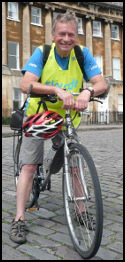I am not a cyclist. As Mikael Coalville-Anderson, author of Copenhagenize said:
“I am just a modern city dweller, who happens to use a bicycle to get around because it is safe and efficient”.
I suspect that different countries and groups have differing terms to describe people who ride bikes. In the USA and to a lesser extent in parts of the UK, both with a dominant motor vehicle culture, “cyclist” is the term used; often conjuring up an image of an aggressive male rider dressed in Lycra. In Oxford the Copenhagenize description seems to fit better.
The sad part is that when applying the term cyclist, this lumps together all people who ride bikes, most of whom are considerate of other road users and not at all aggressive. That’s not to deny that there are some uncooperative and aggressive people who ride bikes. These are a small minority.
All “cyclists” are people, many of whom walk, drive and use public transport in addition to riding. Pejorative descriptions lumping people together under one heading are unhelpful. All are people, on foot and on bikes, people on buses and people driving cars; much the better terminology. It also emphasises that all are people and many of them are at one time or another may use all these modes of transport.
The most vulnerable of these groups, people on foot and on bikes are frequently forced to share the same space allowing the potential for conflict. The paths created by Sustrans often are based on these groups sharing and, given the length of the National Cycle Network, by and large few problems arise. Indeed the title, Sustrans, means sustainable transport for all, so most off-road paths are shared by people on foot and on bikes, people in wheelchairs, people on horses and little people being pushed in buggies. In Oxford, river and canal towpaths and some pavements are shared. Although often the space is too narrow for both groups to operate properly. It is only through goodwill and consideration that these paths work.
Walkers and bike riders prefer when they are allocated separate spaces. This is not always possible, because motor vehicles are given the highest priority when it comes to space. Looking at countries like the Netherlands and Denmark we can see what can be achieved when people on foot and on bikes are given the highest priority. In Oxford there are some areas given over entirely to people riding bikes, such as the segregated cycle ways at the side of the ring road and on Donnington Bridge. The County and District Councils should construct more of these segregated spaces and push ahead with Low Traffic Neighbourhoods, where in residential areas “rat running” motor traffic is prevented, making it safer for residents, whatever their mode of transport.
Perhaps the future of Oxford can be similar to Denmark, where all people on bikes fit Coalville-Anderson’s description of bike riders in the first paragraph.
Roger Symonds
Blog: www.twowheelsgood.org.uk
Published in the Oxford Mail on Tuesday 17th March 2020 – Cyclox’ column, On “Yer Bike”

 Hello, I'm Roger Symonds and I have created this blog to highlight local and wider cycling issues. Given the incredible interest and increase in cycling we must not miss this opportunity to provide the the infrastructure that gets even more people out on bikes in a safer environment.
Hello, I'm Roger Symonds and I have created this blog to highlight local and wider cycling issues. Given the incredible interest and increase in cycling we must not miss this opportunity to provide the the infrastructure that gets even more people out on bikes in a safer environment.